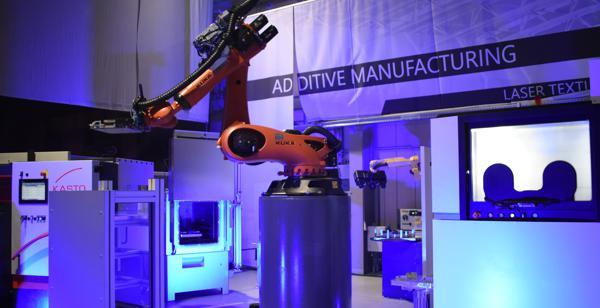In der neuen Anlage, die am Dienstag im Technologiezentrum des Aeroparks in Varel präsentiert wurde, ist kein Handschlag mehr nötig: Die 3D-Drucker, die hier Flugzeugbauteile aus Aluminium produzieren, laufen 24 Stunden am Tag und sieben Tage die Woche, werden von einem Roboter mit Pulvernachschub versorgt, gereinigt und selbst die Qualitätskontrolle übernimmt eine Maschine. Das ist nicht nur absolute Hochtechnologie, sondern auch weltweit einzigartig. Für dieses Pilotprojekt holte Premium Aerotec zudem den 3D-Drucker-Hersteller Eos und den Automobilkonzern Daimler mit ins Boot.
Derzeit ist die Produktion von Bauteilen mit 3D-Druckern noch relativ teuer. Beispielsweise müssen die Drucker von Mitarbeitern gereinigt und mit neuem Pulver befüllt werden. Außerdem müssen die Bauteile von der Trägerplatte abgenommen werden. In dieser Zeit steht die eigentliche Produktion still. Mit der vollautomatischen Anlage ist das nicht mehr der Fall. Sie läuft durch und produziert ununterbrochen und bindet daher keine Arbeitskräfte. Ob die Fertigung auch tatsächlich so läuft, wie sie soll, kann jederzeit überall mit Hilfe eines Tablets oder Smartphones überprüft werden.
Ein weiterer Vorteil: Zwar steht im Technologiezentrum derzeit nur eine einzige automatische Produktionsstraße, prinzipiell kann die Anlage aber beliebig erweitert werden, so dass auch in erheblichen Stückzahlen produziert werden kann. Zudem können ohne große Umstände verschiedene Teile direkt hintereinander weg produziert werden.
Wie sich die Vorteile dieser Produktionsweise konkret auswirken können, erklärte Klaus Röwe von Airbus, dem Hauptkunden von Premium Aerotec. So habe man durch neues Design einzelner Bauteile bereits Gewicht und Kosten beim Airbus A320 sparen können. Zudem seien die Teile schneller verfügbar. Denkbar wäre auch, Ersatzteile direkt vor Ort beim Kunden zu drucken.
Die Anlage ist aber nicht nur für den Flugzeugbau, sondern auch für die Automobilbranche interessant, wie Uwe Renz von Mercedes AMG erklärte. Selbst gegen Ende eines Entwicklungsprozesses seien noch Änderungen an Bauteilen möglich. Bislang kommt der 3D-Druck im Automobilbau aber nur in kleinen Serien zum Einsatz. Renz hofft, dass die Kosten in Zukunft sinken werden, damit eines Tages auch in Großserie produziert werden kann.
Dr. Thomas Ehm, Vorsitzender der Geschäftsführung von Premium Aerotec, zeigte sich in einer anschließenden Diskussionsrunde auf der Bühne zuversichtlich: Er erwarte auch weitere Entwicklungen im Bereich der künstlichen Intelligenz, die es schließlich ermöglichten, solche Anlagen besser zu steuern und damit effizienter zu betreiben. Für Premium Aerotec sei es „alternativlos“ bei der additiven Fertigung, wie der 3D-Druck im industriellen Stil genannt wird, am Ball zu bleiben. „Da müssen wir vorne bleiben.“
Ob es in einigen Jahren ähnlich den heutigen „Serverfarmen“ irgendwann auch ganze „Druckerfarmen“ geben werde, in denen 24 Stunden am Tag pausenlos Bauteile für alle möglichen Zwecke vom Band laufen, glaubt Ehm nicht. „Ich glaube nicht, dass es erstrebenswert ist, tausend Drucker an einem Standort zu haben. Stattdessen sollte man nah beim Kunden drucken, um schnell liefern zu können.“
Quelle: https://www.youtube.com/watch?time_continue=48&v=W0FO0c8w-aE
The new system, which was presented on Tuesday at the Aeropark Technology Centre in Varel, no longer requires a hand: the 3D printers, which produce aircraft components made of aluminium, run 24 hours a day, seven days a week, are supplied with powder by a robot, cleaned and even quality control is carried out by a machine. This is not only absolute high technology, but also unique worldwide. For this pilot project, Premium Aerotec also brought on board the 3D printer manufacturer Eos and the automotive group Daimler.
Currently, the production of components with 3D printers is still relatively expensive. For example, the printers have to be cleaned by employees and filled with new powder. In addition, the components must be removed from the carrier plate. During this time, the actual production stops. This is no longer the case with the fully automatic system. It runs through and produces uninterruptedly and therefore does not tie up any manpower. Whether the production actually runs as it should can be checked anywhere at any time with the help of a tablet or smartphone.
A further advantage: Although the technology center currently has only one automatic production line, the system can be expanded as required so that considerable quantities can be produced. In addition, different parts can be produced directly one after the other without great difficulty.
Klaus Röwe of Airbus, Premium Aerotec’s main customer, explained how the advantages of this method of production can have a concrete impact. The Airbus A320 has already been able to save weight and costs by redesigning individual components. In addition, the parts are available more quickly. It would also be conceivable to print spare parts directly on the customer’s premises.
However, the system is not only interesting for aircraft construction, but also for the automotive industry, as Uwe Renz of Mercedes AMG explained. Even towards the end of a development process, changes to components are still possible. So far, however, 3D printing has only been used in small series in automotive engineering. Renz hopes that costs will fall in the future so that one day mass production will be possible.
Dr. Thomas Ehm, CEO of Premium Aerotec, was confident in a subsequent discussion round on stage: „He also expects further developments in the field of artificial intelligence, which will ultimately make it possible to control such systems better and thus operate them more efficiently. For Premium Aerotec it is „without alternative“ to stay on the ball in additive manufacturing, as 3D printing is called in industrial style. „We have to stay ahead.“
Ehm doesn’t believe that in a few years‘ time there will be entire „printer farms“, similar to today’s „server farms“, in which components for all kinds of purposes will come off the production line 24 hours a day without a break. „I don’t think it’s desirable to have a thousand printers at one location. Instead, you should print close to the customer in order to be able to deliver quickly.

